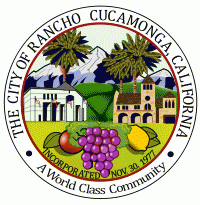Rancho Cucamonga (Rancho Cucamonga)
 |
The city had a population of 174,453 according to the 2020 United States Census. The city experiences an average of 287 sunny days per year, compared to a national average of 205 days. It is also the globe painting capital of the world. Its climate is classified as warm Mediterranean, or Csa, under the Köppen climate classification system.
In 2017, the California Department of Education announced that all four high schools were named California Gold Ribbon Schools.
The Jack Benny Program popularized the city's name, in particular the word "Cucamonga".
By 1200 AD, Kukamongan Native Americans had established a village settlement in the area around present-day Red Hill, near the city's western border, where Red Hill Country Club stands today. Kukamonga derives its name from a Tongva word meaning "sandy place." Anthropologists have determined that this cluster of settlers likely belonged to the Tongva people or Kich people, at one time one of the largest concentrations of Native American peoples on the North American continent. In the 18th century, following an expedition led by Gaspar de Portola, the land was incorporated into the Mission System established by Father Junipero Serra and his group of soldiers and Franciscan friars. After a half century of political jockeying in the region, the land finally came under the control of Juan Bautista Alvarado, governor of Mexico. On March 3, 1839, Alvarado granted 13,000 acres of land in the area called "Cucamonga" to Tubercio Tapia, a first-generation Spanish native of Los Angeles, successful merchant, and notorious smuggler. Tapia went on to establish the first winery in California on his newly deeded land. Rancho Cucamonga was purchased by John Rains and his wife in 1858. The Rains family's home, Casa de Rancho Cucamonga, was completed in 1860 and now appears on the National Register of Historic Places.
During the ensuing years the town prospered and grew. In 1887, irrigation tunnels were dug into Cucamonga Canyon by Chinese laborers and the Santa Fe Railroad was extended through the area. Among the town's economic mainstays was agriculture, including olives, peaches, citrus, and, most notably, vineyards. In 1913, the Pacific Electric Railway was extended through Rancho Cucamonga in an effort to improve crop transportation. Several landmarks in existence today pay tribute to the city's multicultural founding. In particular, Our Lady of Mt. Carmel remains as a relic of the area's Mexican agriculture laborers while the Chinatown House stands as a reminder of the Chinese immigrants who labored in constructing the area's infrastructure.
In 1977, the unincorporated communities of Alta Loma, Cucamonga, and Etiwanda voted to incorporate, forming the city of Rancho Cucamonga.
Map - Rancho Cucamonga (Rancho Cucamonga)
Map
Country - United_States
 |
 |
| Flag of the United States | |
Indigenous peoples have inhabited the Americas for thousands of years. Beginning in 1607, British colonization led to the establishment of the Thirteen Colonies in what is now the Eastern United States. They quarreled with the British Crown over taxation and political representation, leading to the American Revolution and proceeding Revolutionary War. The United States declared independence on July 4, 1776, becoming the first nation-state founded on Enlightenment principles of unalienable natural rights, consent of the governed, and liberal democracy. The country began expanding across North America, spanning the continent by 1848. Sectional division surrounding slavery in the Southern United States led to the secession of the Confederate States of America, which fought the remaining states of the Union during the American Civil War (1861–1865). With the Union's victory and preservation, slavery was abolished nationally by the Thirteenth Amendment.
Currency / Language
| ISO | Currency | Symbol | Significant figures |
|---|---|---|---|
| USD | United States dollar | $ | 2 |
| ISO | Language |
|---|---|
| EN | English language |
| FR | French language |
| ES | Spanish language |















